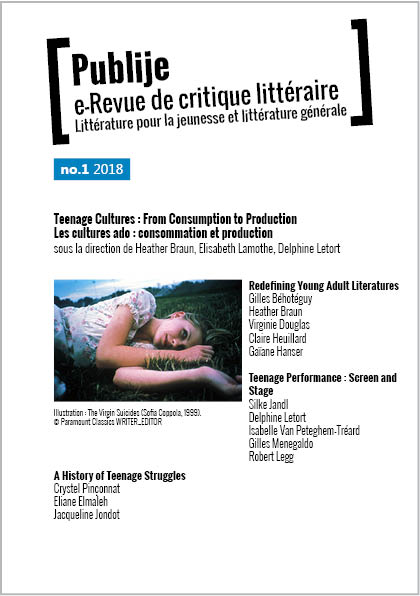Beyond Katniss: The Resilient Young Heroines of YA Problem Novels
Mots-clés :
émancipation, ‘empowerment’, genre, féminité, roman pour jeunes adultes, emancipation, femininity, gender, YA novelRésumé
At least since the publication of Twilight (Stephanie Meyer, 2005) and Hunger Games (Suzanne Collins, 2008), discussions of heroines in young adult literature have focused largely on female leads who are fighting for survival against supernatural creatures or dystopian regimes. More recently, however, attention has been shifting away from such idealized heroines to more realistic role models such as the ones we meet in Eleanor and Park (Rainbow Rowell, 2013) and The Miseducation of Cameron Post (Emily Danforth, 2012). At the center of these novels are complex young women, flawed and resilient, whose fierce independence and refusal to be normalized by romance or social expectations result in a fuller sense of who they are and who they wish to become. Moreover, these new YA heroines inhabit familiar landscapes that adolescent readers are also learning to navigate. As such, Eleanor and Cam offer welcome alternatives to the extremes of Bella and Katniss. Indeed, as YA literature claims a more established place as a meaningful fictional genre, young readers could gain greater confidence and self-knowledge by encountering more heroines like Eleanor and Cam.
Depuis la publication de Twilight (Stephanie Meyer, 2005) et de Hunger Games (Suzanne Collins, 2008), les débats portant sur les héroïnes de la littérature pour jeunes adultes se sont concentrés sur les personnages principaux qui mènent un combat contre des forces surnaturelles ou contre des régimes dystopiques. Plus récemment toutefois, le point de mire s’est détourné de ces héroïnes idéalisées et s’est fixé sur les modèles plus réalistes que l’on peut trouver dans Eleanor et Park (Rainbow Rowell, 2013) et The Miseducation of Cameron Post (Emily Danforth, 2012). Les jeunes femmes au cœur de ces romans ne sont pas dénuées de défauts mais elles sont aussi dotées de résilience ; elles affichent une indépendance farouche et refusent de suivre les conventions sociales normalisées par les histoires d’amour afin de comprendre véritablement qui elles sont et qui elles souhaitent devenir. De plus, ces nouvelles héroïnes évoluent dans des milieux familiers pour leur lectorat adolescent. Eleanor et Cam offrent ainsi des alternatives bienvenues aux personnages extrêmes qu’étaient Bella et Katniss. En effet, alors que la littérature pour jeunes adultes revendique une place plus importante dans le domaine des œuvres de fiction, des héroïnes comme Eleanor et Cam devraient permettre aux jeunes lectrices de gagner en confiance et en connaissance de soi.
Téléchargements
Publiée
Comment citer
Numéro
Rubrique
Licence
Les auteurs qui publient dans cette e-revue acceptent les termes suivants :
Les auteurs conservent le droit d'auteur et accordent à la revue le droit de première publication, sous la licence Licence d’attribution Creative Commons permettant à d'autres de partager les articles tout en en reconnaissant la paternité et la publication initiale dans cette revue.





